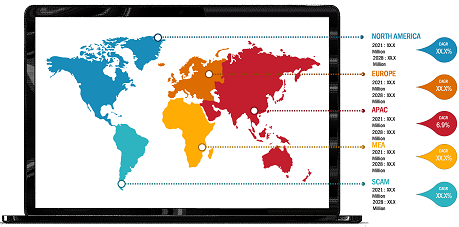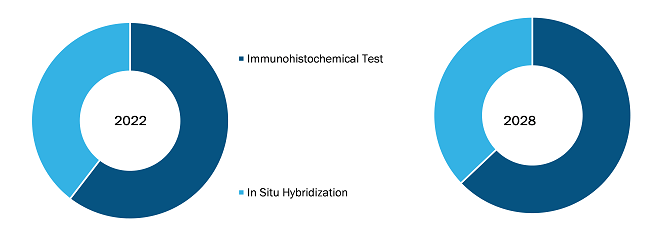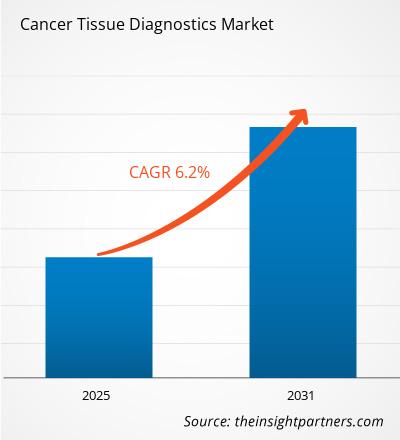Der Markt für Krebsgewebediagnostik soll bis 2031 von 2.538,31 US-Dollar auf 3.640,87 Millionen US-Dollar ansteigen Millionen im Jahr 2022; Von 2022 bis 2031 wird ein durchschnittliches jährliches Wachstum von 6,2 % erwartet.
Techniken der Krebsgewebediagnostik werden verwendet, um einen Tumor in bösartigem Gewebe zu erkennen. In den letzten Jahren wurde die Immunhistochemie (IHC) eingesetzt, um den Nachweis spezifischer Antigene im Tumorgewebe zu verbessern. Mit Hilfe nichtfluoreszierender Chromogene wird das Screening mit konventioneller Mikroskopie analysiert. Für die Diagnose von Krebsgewebe wurden neuere Techniken entwickelt. Mithilfe der Fluoreszenz-in-situ-Hybridisierung wird eine genetische Anomalie im Genom untersucht. Die hybridisierte Desoxyribonukleinsäure (DNA) wird mit bestimmten Sonden untersucht.
Die Markt für Krebsgewebediagnostik wird auf Grundlage dieser Segmentierung segmentiert Je nach Testtyp und geografischer Lage ist der Markt in immunhistochemische Tests und In-situ-Hybridisierungstests unterteilt. Im Jahr 2022 hatte das Segment der immunhistochemischen Tests einen größeren Marktanteil. Auch der Markt im gleichen Segment wird in den kommenden Jahren voraussichtlich schneller wachsen. Geographisch gesehen ist der Markt für Krebsgewebediagnostik grob in Nordamerika, Europa, den asiatisch-pazifischen Raum, den Nahen Osten und andere Regionen unterteilt. Afrika sowie Süd- und Afrika Zentralamerika. Der Markt im asiatisch-pazifischen Raum dürfte im Prognosezeitraum aufgrund der steigenden Krebsprävalenz und der zunehmenden Alterung der Bevölkerung in asiatischen Ländern am stärksten wachsen. Die japanische Regierung hat zahlreiche Initiativen und Programme formuliert und umgesetzt, um die Qualität der Krebsbehandlung zu verbessern und das Bewusstsein für Krebs im Land zu schärfen. In China wurden nach Angaben der WHO im Jahr 2021 45.68.754 neue Krebsfälle entdeckt und 30.02.899 Krebstodesfälle im Land verzeichnet. Der Bericht zur Krebsgewebediagnostik bietet Einblicke und eine eingehende Analyse des Marktes, betont Parameter wie Markttrends, technologische Fortschritte, Marktdynamik und die Wettbewerbsanalyse der weltweit führenden Marktteilnehmer.
Strategische Einblicke
Lukrative Regionen für den Markt für Krebsgewebediagnostik

Markteinblicke
Neue Produkteinführungen und FDA-Zulassungen sowie wachsende Investitionen in die Krebsgewebediagnostik, um den Markt für Krebsgewebediagnostik im Prognosezeitraum anzukurbeln
Die meisten großen Marktteilnehmer sind an der Herstellung einer breiten Palette von Produkten für die Krebsdiagnostik beteiligt und bieten ein Höchstmaß an Vorteile und frühzeitige Diagnose. Im Juni 2022 kündigte Roche die Einführung des BenchMark ULTRA PLUS-Systems an, seiner neuesten fortschrittlichen Gewebefärbeplattform. Das System ermöglicht schnelle und genaue Testergebnisse, sodass Ärzte zeitnahe Entscheidungen bezüglich der Behandlungsreise eines Patienten treffen können.
Im März 2022 führte Illumina in Europa einen neuen In-vitro-Diagnosetest ein, der verschiedene Krebsmutationen profilieren und Patienten dabei helfen soll, gezielte Therapien zu finden. Somit beschleunigen die ständigen technologischen Weiterentwicklungen in der Diagnostik und die FDA-Zulassungen das Marktwachstum.
Im Mai 2021 hat QIAGEN NV einen erweiterten Umfang von Companion Diagnostic (CDx)-Ansprüchen für das therascreen KRAS RGQ PCR Kit (therascreen KRAS Kit) eingeführt, nachdem es in den USA die behördliche Zulassung als Companion Diagnostic zur Unterstützung erhalten hatte Identifizierung von Patienten mit nicht-kleinzelligem Lungenkrebs (NSCLC), die möglicherweise für eine Behandlung mit LUMAKRASTM (Sotorasib) in Frage kommen, einer neu zugelassenen Therapie, die von Amgen Inc. (AMGN) entwickelt und vermarktet wird. Darüber hinaus unterzeichneten Illumina und Roche im Januar 2021 eine 15-jährige, nicht-exklusive Kooperationsvereinbarung zur Realisierung von NGS-Projekten. Potenzial, die Vorhersage, Erkennung, Diagnose, Behandlung und Überwachung des Krebsrisikos zu verändern. Der Wert der Partnerschaft, die Initiativen zur In-vitro-Diagnostik (IVD) und Begleitdiagnostik (CDx) umfasst, wurde nicht bekannt gegeben. Im Jahr 2021 führte das Unternehmen die Cloud-Plattform AIforia ein, die die Bildverarbeitung beschleunigt und eine automatisierte pathologische Bildanalyse ermöglicht. So haben die zunehmenden Kooperationen und neuen technologischen Plattformen in der Krebsgewebediagnostik zum Aufkommen bahnbrechender Techniken geführt, von denen erwartet wird, dass sie das Wachstum des Marktes in den kommenden Jahren ankurbeln werden.
Test Type-Insights
Basierend auf dem Testtyp ist der Markt für Krebsgewebediagnostik in immunhistochemische Tests und In-situ-Hybridisierungstests unterteilt. Im Jahr 2022 hatte das Segment der immunhistochemischen Tests einen größeren Marktanteil. Darüber hinaus wird erwartet, dass der Markt in demselben Segment in den kommenden Jahren aufgrund der Kosteneffizienz der Technik schneller wachsen wird. Darüber hinaus ist die Technik leicht zugänglich und es wird erwartet, dass die Zunahme der Anzahl technologiebasierter Produkte das Segmentwachstum weiter vorantreiben wird.
< span style="Schriftfamilie: Verdana, Genf, serifenlos; Schriftgröße: 10pt;">
- Im Juni 2022 kündigte Roche die Einführung des BenchMark ULTRA PLUS-Systems an, seiner neuesten Weiterentwicklung Plattform zum Färben von Gewebe. Das System ermöglicht schnelle und genaue Testergebnisse, sodass Ärzte zeitnahe Entscheidungen bezüglich der Behandlungsreise eines Patienten treffen können.
- Im März 2022 führte Illumina in Europa einen neuen In-vitro-Diagnosetest ein, der darauf abzielt, verschiedene Krebsmutationen zu profilieren und Patienten bei der Orientierung zu unterstützen zu gezielten Therapien.
- Im Mai 2021 startete QIAGEN NV einen erweiterten Umfang von Companion Diagnostic (CDx)-Ansprüchen für das therascreen KRAS RGQ PCR Kit (therascreen KRAS Kit), nachdem es in den USA die behördliche Zulassung als Companion Diagnostic (CDx) erhalten hatte die Identifizierung von Patienten mit nicht-kleinzelligem Lungenkrebs (NSCLC), die möglicherweise für eine Behandlung mit LUMAKRASTM (Sotorasib) in Frage kommen, einer neu zugelassenen Therapie, die von Amgen Inc. (AMGN) entwickelt und vermarktet wird.
- Im Januar 2021 unterzeichneten Illumina und Roche eine 15-jährige, nicht exklusive Kooperationsvereinbarung mit dem Ziel, das Potenzial von NGS auszuschöpfen und die Vorhersage, Erkennung, Diagnose, Behandlung und Überwachung von Krebsrisiken zu transformieren. Der Wert der Partnerschaft – die Initiativen zur In-vitro-Diagnostik (IVD) und Begleitdiagnostik (CDx) umfasst – wurde nicht bekannt gegeben.
- Im Juni 2021 erhielt Agilent Technologies Inc. die Zulassung der US-amerikanischen Food and Drug Administration (FDA) für seinen PD-L1 IHC 22C3 pharmDx-Assay. Der Assay ist zur Identifizierung von Patienten mit Kopf-Hals-Patienten zugelassen Plattenepithelkarzinom (HNSCC) zur Behandlung mit KEYTRUDA (Pembrolizumab), einer von Merck hergestellten Anti-PD-1-Therapie.
- Im Juni 2021 erhielt der Oncomine Dx Target Test von Thermo Fisher Scientific eine Erstattung durch das japanische Ministerium für Gesundheit, Arbeit und Soziales. Der Test ist jetzt in Japan im Handel erhältlich. Die Erstattung hat dem Unternehmen dabei geholfen, das anzubieten Diagnose von NSCLC.\
- Im Mai 2021 brachte Roche den monoklonalen Kaninchen-Primärantikörper VENTANA ROS1 (SP384) auf den Markt, einen in vitro diagnostischen ROS1-Immunhistochemie-Assay (IHC). Die Einführung hat es dem Unternehmen ermöglicht, bessere innovative Produkte anzubieten.
Firmenprofile
- F. Hoffmann-La Roche Ltd
- Thermo Fisher Scientific Inc
- Bio Rad Laboratories Inc
- Abbott
- Enzo Life Sciences, Inc
- Agilent Technologies, Inc
- Cancer Genetics Inc
- Merck KGaA (Sigma-Aldrich Co. LLC)
- Danaher Corporation
- Abcam plc.
- Historische Analyse (2 Jahre), Basisjahr, Prognose (7 Jahre) mit CAGR
- PEST- und SWOT-Analyse
- Marktgröße Wert/Volumen – Global, Regional, Land
- Branche und Wettbewerbsumfeld
- Excel-Datensatz



Report Coverage
Revenue forecast, Company Analysis, Industry landscape, Growth factors, and Trends

Segment Covered
This text is related
to segments covered.

Regional Scope
North America, Europe, Asia Pacific, Middle East & Africa, South & Central America

Country Scope
This text is related
to country scope.
Trends and growth analysis reports related to Life Sciences : READ MORE..
The List of Companies
- F. Hoffmann-La Roche Ltd.
- Danaher Corporation
- Thermo Fisher Scientific Inc.
- Bio Rad Laboratories Inc.
- Abbott
- Enzo Life Sciences, Inc.
- Agilent Technologies, Inc.
- Cancer Genetics Inc.
- Merck KGaA (Sigma-Aldrich Co. LLC)
- Abcam plc.
The Insight Partners performs research in 4 major stages: Data Collection & Secondary Research, Primary Research, Data Analysis and Data Triangulation & Final Review.
- Data Collection and Secondary Research:
As a market research and consulting firm operating from a decade, we have published and advised several client across the globe. First step for any study will start with an assessment of currently available data and insights from existing reports. Further, historical and current market information is collected from Investor Presentations, Annual Reports, SEC Filings, etc., and other information related to company’s performance and market positioning are gathered from Paid Databases (Factiva, Hoovers, and Reuters) and various other publications available in public domain.
Several associations trade associates, technical forums, institutes, societies and organization are accessed to gain technical as well as market related insights through their publications such as research papers, blogs and press releases related to the studies are referred to get cues about the market. Further, white papers, journals, magazines, and other news articles published in last 3 years are scrutinized and analyzed to understand the current market trends.
- Primary Research:
The primarily interview analysis comprise of data obtained from industry participants interview and answers to survey questions gathered by in-house primary team.
For primary research, interviews are conducted with industry experts/CEOs/Marketing Managers/VPs/Subject Matter Experts from both demand and supply side to get a 360-degree view of the market. The primary team conducts several interviews based on the complexity of the markets to understand the various market trends and dynamics which makes research more credible and precise.
A typical research interview fulfils the following functions:
- Provides first-hand information on the market size, market trends, growth trends, competitive landscape, and outlook
- Validates and strengthens in-house secondary research findings
- Develops the analysis team’s expertise and market understanding
Primary research involves email interactions and telephone interviews for each market, category, segment, and sub-segment across geographies. The participants who typically take part in such a process include, but are not limited to:
- Industry participants: VPs, business development managers, market intelligence managers and national sales managers
- Outside experts: Valuation experts, research analysts and key opinion leaders specializing in the electronics and semiconductor industry.
Below is the breakup of our primary respondents by company, designation, and region:

Once we receive the confirmation from primary research sources or primary respondents, we finalize the base year market estimation and forecast the data as per the macroeconomic and microeconomic factors assessed during data collection.
- Data Analysis:
Once data is validated through both secondary as well as primary respondents, we finalize the market estimations by hypothesis formulation and factor analysis at regional and country level.
- Macro-Economic Factor Analysis:
We analyse macroeconomic indicators such the gross domestic product (GDP), increase in the demand for goods and services across industries, technological advancement, regional economic growth, governmental policies, the influence of COVID-19, PEST analysis, and other aspects. This analysis aids in setting benchmarks for various nations/regions and approximating market splits. Additionally, the general trend of the aforementioned components aid in determining the market's development possibilities.
- Country Level Data:
Various factors that are especially aligned to the country are taken into account to determine the market size for a certain area and country, including the presence of vendors, such as headquarters and offices, the country's GDP, demand patterns, and industry growth. To comprehend the market dynamics for the nation, a number of growth variables, inhibitors, application areas, and current market trends are researched. The aforementioned elements aid in determining the country's overall market's growth potential.
- Company Profile:
The “Table of Contents” is formulated by listing and analyzing more than 25 - 30 companies operating in the market ecosystem across geographies. However, we profile only 10 companies as a standard practice in our syndicate reports. These 10 companies comprise leading, emerging, and regional players. Nonetheless, our analysis is not restricted to the 10 listed companies, we also analyze other companies present in the market to develop a holistic view and understand the prevailing trends. The “Company Profiles” section in the report covers key facts, business description, products & services, financial information, SWOT analysis, and key developments. The financial information presented is extracted from the annual reports and official documents of the publicly listed companies. Upon collecting the information for the sections of respective companies, we verify them via various primary sources and then compile the data in respective company profiles. The company level information helps us in deriving the base number as well as in forecasting the market size.
- Developing Base Number:
Aggregation of sales statistics (2020-2022) and macro-economic factor, and other secondary and primary research insights are utilized to arrive at base number and related market shares for 2022. The data gaps are identified in this step and relevant market data is analyzed, collected from paid primary interviews or databases. On finalizing the base year market size, forecasts are developed on the basis of macro-economic, industry and market growth factors and company level analysis.
- Data Triangulation and Final Review:
The market findings and base year market size calculations are validated from supply as well as demand side. Demand side validations are based on macro-economic factor analysis and benchmarks for respective regions and countries. In case of supply side validations, revenues of major companies are estimated (in case not available) based on industry benchmark, approximate number of employees, product portfolio, and primary interviews revenues are gathered. Further revenue from target product/service segment is assessed to avoid overshooting of market statistics. In case of heavy deviations between supply and demand side values, all thes steps are repeated to achieve synchronization.
We follow an iterative model, wherein we share our research findings with Subject Matter Experts (SME’s) and Key Opinion Leaders (KOLs) until consensus view of the market is not formulated – this model negates any drastic deviation in the opinions of experts. Only validated and universally acceptable research findings are quoted in our reports.
We have important check points that we use to validate our research findings – which we call – data triangulation, where we validate the information, we generate from secondary sources with primary interviews and then we re-validate with our internal data bases and Subject matter experts. This comprehensive model enables us to deliver high quality, reliable data in shortest possible time.

 Holen Sie sich ein kostenloses Muster für diesen Bericht
Holen Sie sich ein kostenloses Muster für diesen Bericht